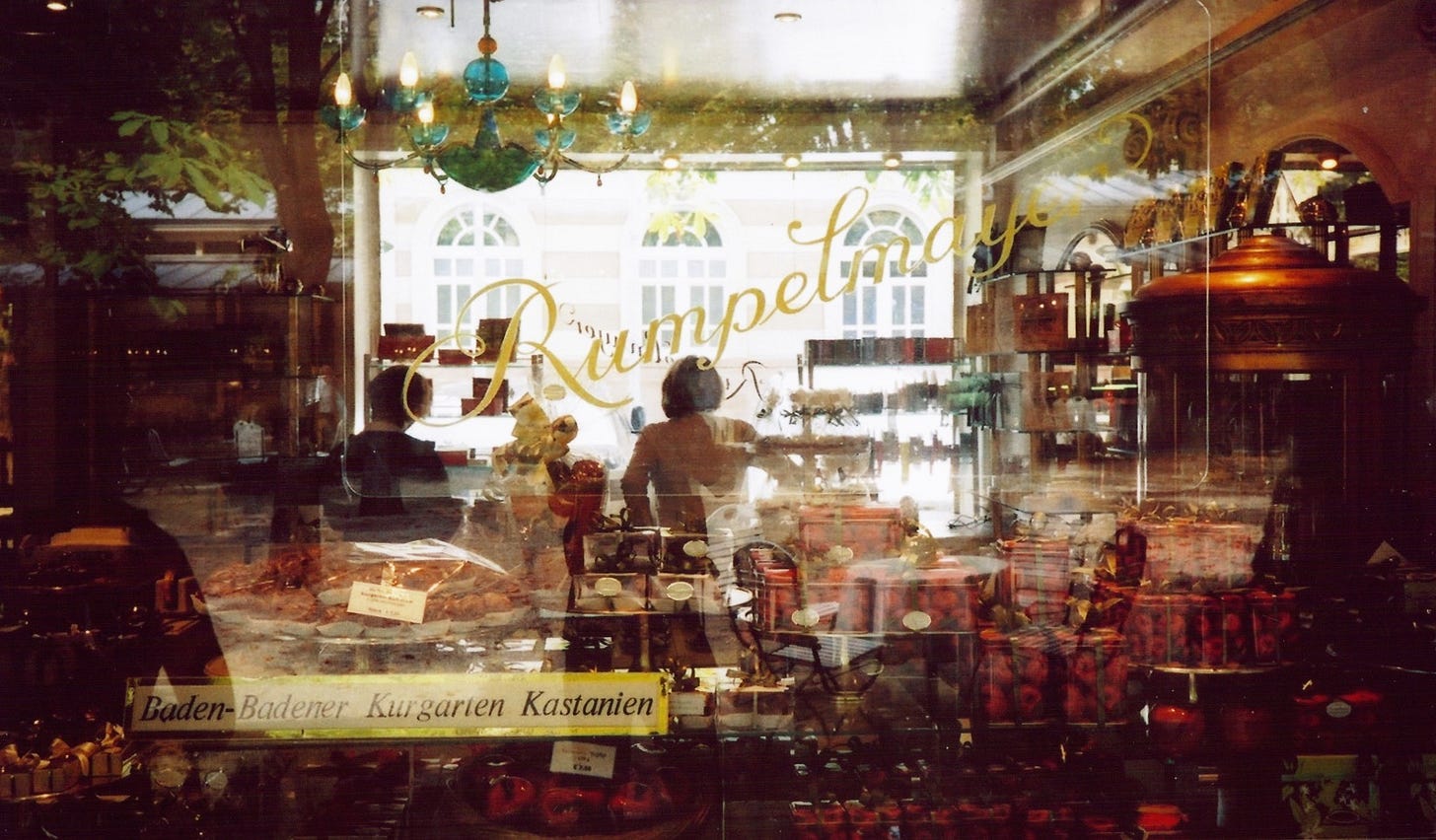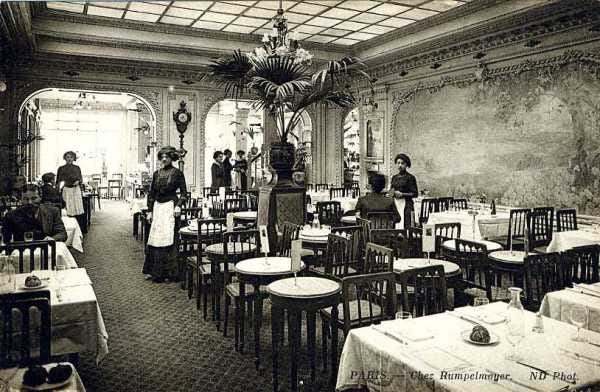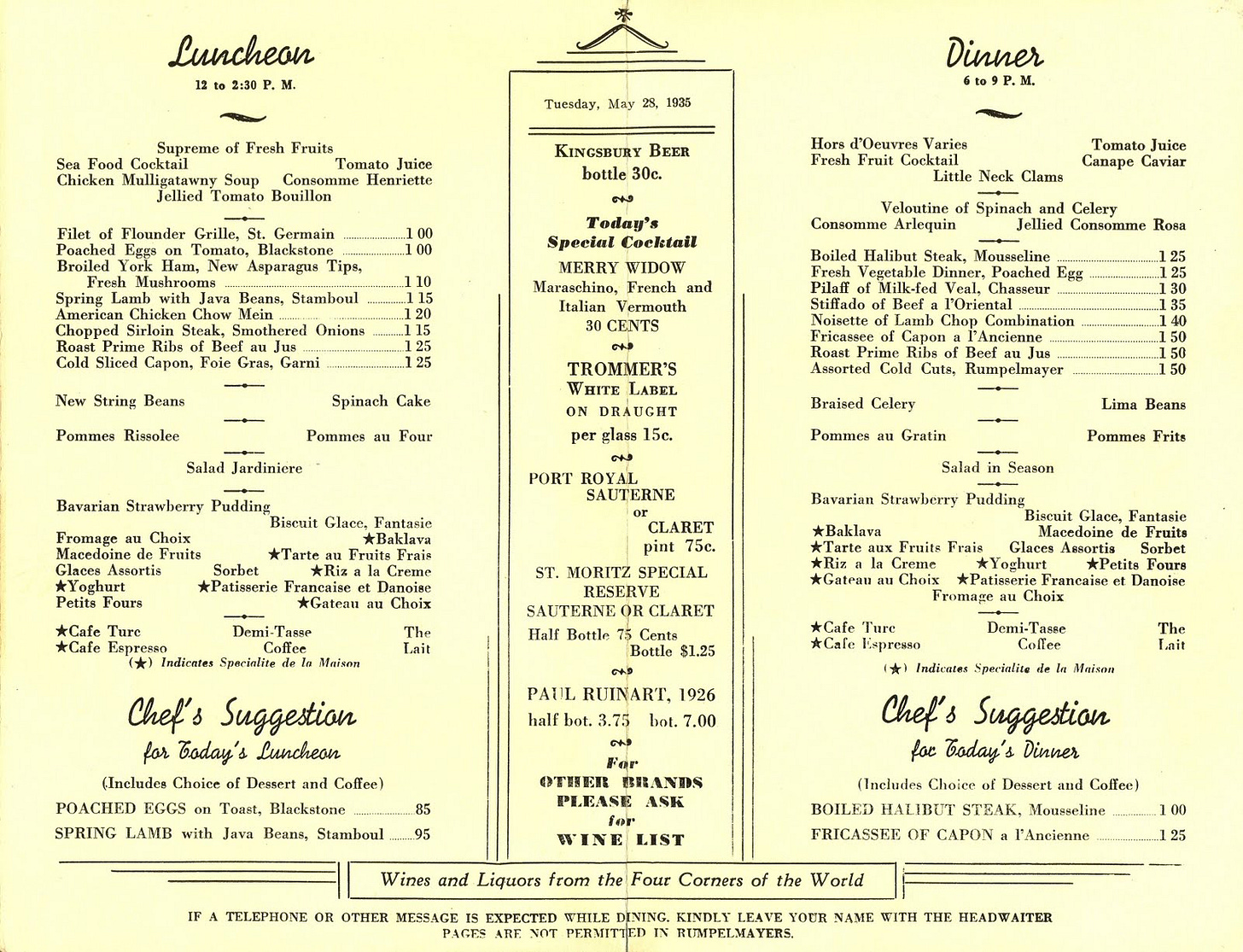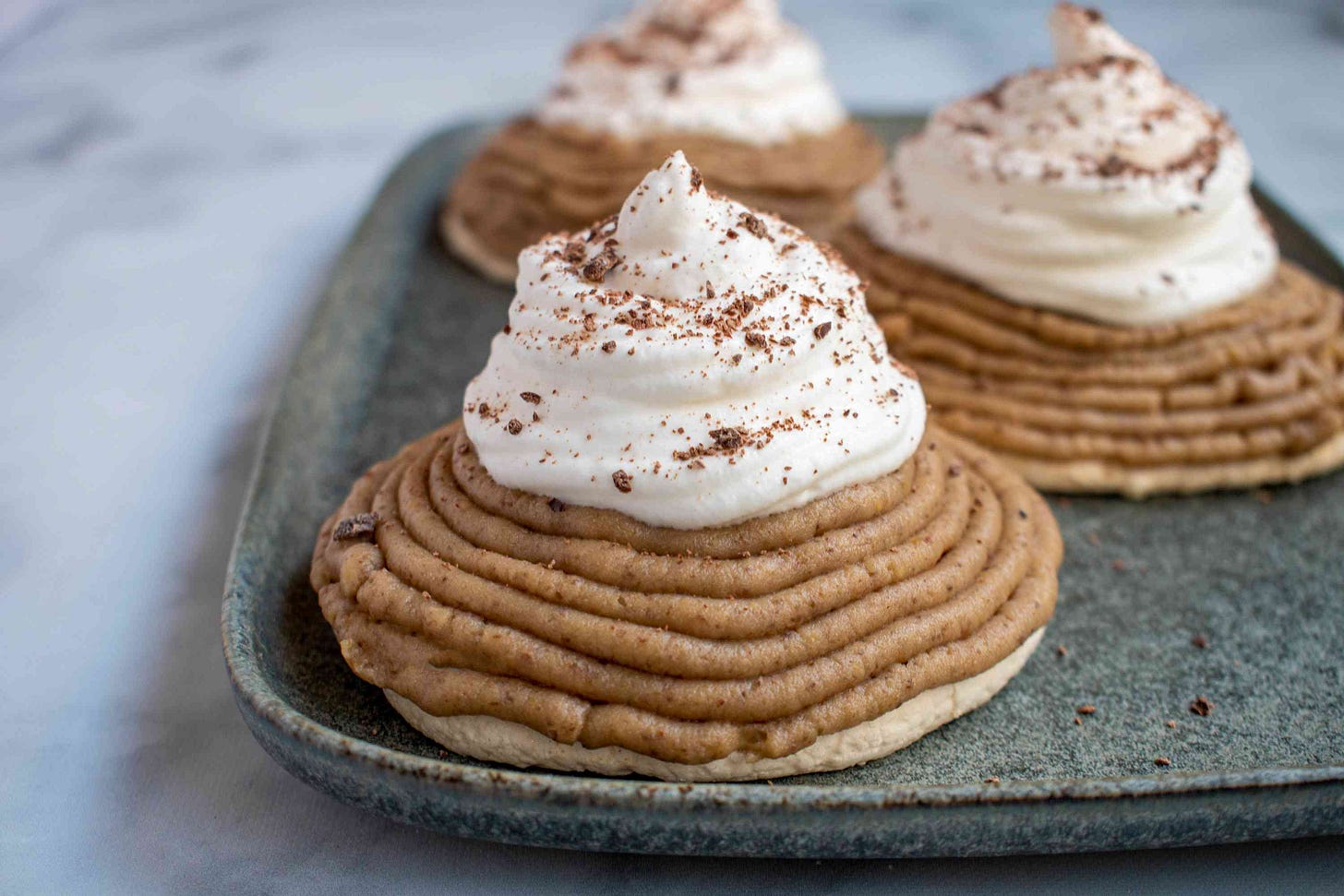The Book of Lies - Chapter 68
Rumpelmayer's, London, circa 1913
To start, I want to make a few corrections to The Decadent Diet of Aleister Crowley article, and these are all thanks to the online Aleister Crowley Society on LAShTAL.com, collectively calling themselves Lashtalians. One poster questioned if I was lurking there. As another contributor apprised me of the discussion thread, then - yes - I am occasionally taking a peak and am much appreciative of leads given, suggestions offered, and corrections made. Specifically, I owe much thanks to self-ascribed nitpicker, whom I may have to employ as a fact checker:
Confessions was not Crowley’s personal journals, and while I erroneously stated Confessions include extensive commentary upon culinary offerings, et al, I maintain that it has proven to be a source of great gastronomic tidbits which are rabbit holes I invariably fall into.
“In 1899, when he was just 22 years old,” is just plain bad math on my part. As he was born in 1875, he would have been between 23 or 24 in 1899, depending on the time of year.
I stated that he brought a handful of acolytes to Boleskin in 1918, and have been advised that Crowley was in America at this point. This just shows me that I have to get back to the project of databasing all of the pertinent dates of where he was, and with whom.
Now on to Rumpelmayer’s and The Book of Lies. I am grateful to another old friend, Frater CCM, who pointed me Chapter 68, Manna:
At four o’clock there is hardly anybody in Rumpelmayer’s.
I have my choice of place and service; the babble of the apes will begin soon enough.
”Pioneers, O Pioneers!”
Sat no Elijah under the Juniper-tree, and wept?
Was not Mohammed forsaken in Mecca, and Jesus in Gethsemane?
These prophets were sad at heart; but the chocolate at Rumplemayer’s is great, and the Mousse Noix is like Nypthys for perfection.
Also, there are little meringues with cream and chestnut-pulp, very velvety seductions.
Sail I not towards LAYLAH within seven days?
Be not sad at heart, O prophet; the babble of the apes will presently begin.
Nay, rejoice exceedingly; for after all the babble of the apes the Silence of the Night.
And the COMMENTARY:
Manna was a heavenly cake which, in the legend, fed the Children of Israel in the Wilderness. The author laments the failure of his mission to mankind, but comforts himself with the following reflections:
He enjoys the advantages of solitude.
Previous prophets encountered similar difficulties in convincing their hearers.
Their food was not equal to that obtainable at Rumpelmayer’s.
In a few days I am going to rejoin Laylah.
My mission will succeed soon enough.
Death will remove the nuisance of success.
I was initially tempted to dive into the analysis of manna, and offer a basic recipe, as that is the title of this chapter. Perhaps I will at a later date, but there is so much more gastronomically speaking in this chapter than some bread that has fallen from the sky. Gastronomically, this chapter is all about Rumpelmayer’s (pronounced Room-pel-may-AIRE) with its decadent Mousse Noix and meringues with chestnut purée and whipped cream.
Anton (or Antoine, depending on who you speak with) Rumpelmayer (1832-1914) was an important Austrian confectioner. How important? Well, he held the k.u.k. Hoflieferant distinction, meaning he was enlisted as a “Purveyor to the Royal and Imperial Court,” when discovered by the Empress Elisabeth of Austria-Hungary. In 1896, she received him at the Vienna Court to award him the honor of Hofzuckerbäcker (“Confectioner to the Court”). First Anton’s business endeavors were purely sweet ones. He owned a factory in Dresden that produced chocolate candies, fruit preserves, and sweet pastries, with shops in Baden-Baden, Bad Nauheim, Berlin, and Frankfurt. The picture above is from the Baden-Baden store which is still open to this day.
In 1913 Anton opened his shop at 226 Rue de Rivoli in Paris with his son, René (a renowned soldier and balloonist!), and expanded beyond a mere confectionery shop to being an upscale teahouse and meeting place of Parisian beau monde. Known as the Angelina tea-house — after René’s wife who was widowed in 1915, during WWI. This is where fame grew and soon franchises were sold and more cafés opened, notably on St. James’ Street in London, and by the early 1930s, in the Hotel St. Moritz at Central Park in New York City (the latter more known for its garish pink décor, stuffed teddy bears, and gourmet ice cream). Becoming more than just a sweet shop or teahouse, the expanded Rumpelmayer cafés offered more extensive menus.
A notable eatery, ostensibly known amongst the well-traveled and well-to-do of fin de siècle sophisticates who have experienced it, perhaps, in Baden-Baden or Monte Carlo, Nice or London, Paris or New York City, this is very likely what Crowley would have seen entering a circa 1912 Rumpelmayer’s, be it in Paris or London:
Rumpelmayer’s may also be ringing a literary bell if you have read Virginia Woolf’s Mrs Dalloway who utilized the London café’s catering: Mrs. Dalloway said she would buy the flowers herself. For Lucy had her work cut out for her. The doors would be taken off their hinges; Rumpelmayer’s men were coming. And then, thought Clarissa Dalloway, what a morning — fresh as if issued to children on a beach.
As Crowley waxes poetic about Rumpelmayer’s and not Angelina, it is easy to make an educated assumption that the Book of Lies reference is for the London establishment, although I am confident he frequented both if his adoration for the Mousse Noix is any indication. The oldest full menu I could find is from the 1935 New York café and doesn’t list either a Mousse Noix or meringues. However, since the Bavarian Strawberry Pudding is a seasonal addition to this menu, it is safe to say this is a late spring or summer menu, while chestnuts would typically be a fall flavor. It may also be likely that many take-away pastries and sweets wouldn’t be on a menu at all, but in a display case. It is interesting that this New York version has a very international-leaning Americanized menu, with its South Indian Mulligatawny soup, Frenchified potatoes (pommel), Chinese Chow Mein, and a Spring Lamb with Java Beans Stamboul (Turkish). Any self-respecting British menu would have had that Spring Lamb served with mint jelly and is unlikely to include Chinese offerings during the Edwardian era.
Philosophically, there is ardor in Crowley’s spiritual exaltation of Rumpelmayer’s. He is thrilled that he has arrived early enough to escape the crowds that are due to descend. He can choose his preferred seat and possibly a favored waitress. Then there is deep-felt lamentation that other prophets were disdained by or still lacked followers, but even more dispiriting to his predecessors, that their victuals couldn't compare with the fact that he can experience a transfiguration through the consumption of Rumpelmayer’s chocolate (this was probably a cup of hot chocolate, for which they were well known, but Crowley may have been referring to covered bonbons and the couverture used in other sweet creations). Sexuality is implied, both in a Mousse Noix and in a meringue that is a “very velvety seduction.” On the mouth, mousses, meringues, and whipped creams are very seductive and sensual feeling foods. With a well-made meringue, specifically, one experiences a sense of contradiction in the slight crunch of the exterior of the meringue before it gives way to an ethereally light interior that dissipates almost immediately upon the tongue.
Let’s take the Mousse Noix first, and Crowley’s similitude towards Nepthys, the protective Egyptian sister of Isis and Osiris, who symbolizes the experience of death; a recurring theme in initiatory literature. Mousse is one of the grandest desserts because it is made with great care with shockingly few ingredients, but is adaptable and changeable into many different flavors, all of which are transcendently light and incredibly rich. I am very grateful to Sarah Wassberg’s blog which covers the history of mousse, as I was succumbing to multitudes of contradictory recipe information: eggs or no eggs? Some 19th century recipes include eggs, either whipped egg whites or a richer version that includes a whole egg or egg yolk for a custardy richness. By the 20th century, there is an addition of gelatin which is a total short-cut/cop-out to get stabilization of the ingredients once they are whipped up into volume. All my 19th century cookbooks list mousses in their chapters on “Ices” as the basic instruction is to whip cream until stiff, slowly add in powdered sugar and flavor (be it melted chocolate, puréed fruit or nuts, or a floral hint like rose water), fill a mould, and then freeze until service. I haven’t been able to discern how Rumpelmayer’s mousse might have been made; with eggs or sans, but know that it is “is like Nypthys for perfection.” That Crowley invokes a deity of transition (death), to me insinuates that the mousse he is consuming is transformative and is able to take him to a separate realm of consciousness. In short, as Frater CCM reminded me, the “Mousse Noix is literally to die-for.”
But it isn’t just Rumpelmayer’s mousse that is so revelatory, there also “are little meringues with cream and chestnut-pulp, very velvety seductions.” This is easier to research, thankfully. There is a classic, layered dessert known as Mont Blanc in which chestnut purée is lightened with a bit of sugar and water, so it can be piped atop a meringue and finished with a heaping dollop of whipped cream. It looks something like this:
From my reading, I believe Rumpelmayer “deconstructed” the classic Mont Blanc plated dessert into something smaller, that could be eaten in a bite or two with tea. It would be very simple to create the meringue in a smaller, more manageable bite — either as a “kiss” as you see on the left, or as a “nest” on the right — which then would have whipped cream and puréed chestnut as its complement.

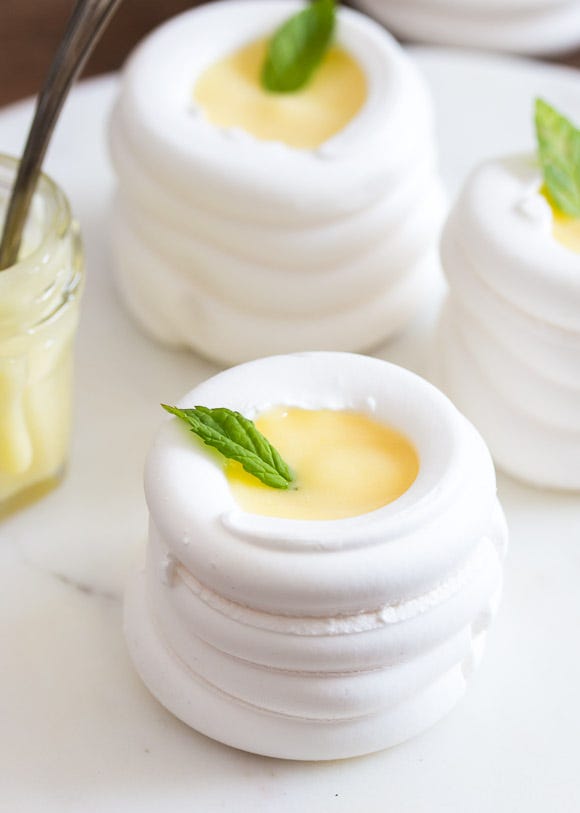
I can see that as this investigation expands, I am going to have to do a considerably amount of recipe testing for you all, and present workable recipes to recreate these wonders in your own home. Please share your feedback if this is something you would enjoy, or if just reading about them is sufficient. I know now I am really craving a meringue with whipped chestnut and cream.
As always, thank you for your continued support!


